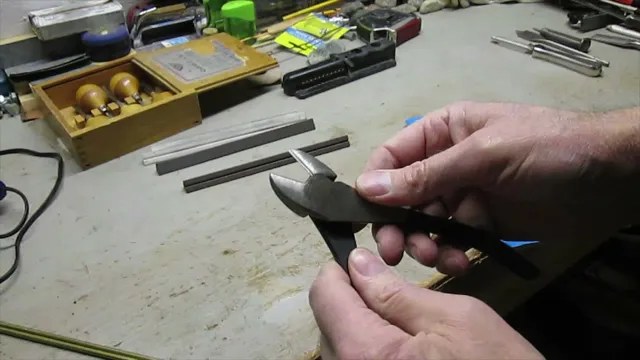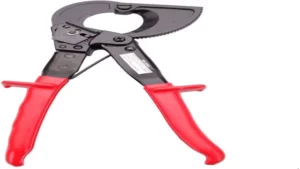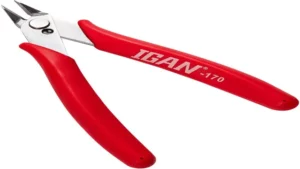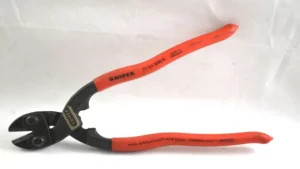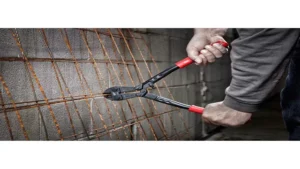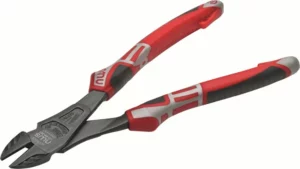Wire cutters are an essential tool for a variety of DIY and industrial tasks, from cutting metal wires to snipping through plastic and electrical cables. However, like any other tool, they have a limited lifespan and require maintenance to stay sharp and effective. If you’ve been struggling with blunt and ineffective wire cutters, it’s time to learn how to sharpen them and extend their lifespan.
In this blog post, we’ll guide you through the process of sharpening wire cutters, step by step, and provide you with tips and tricks to make the process a breeze. So, grab your wire cutters and let’s get started!
Tools Needed
Wire cutters are an essential tool for many different types of jobs, but like any tool, they can become dull over time and lose their effectiveness. If you’ve found that your wire cutters aren’t working as well as they used to, it may be time to sharpen them. The good news is that sharpening wire cutters is a relatively simple process, and you don’t need a lot of specialized tools to do it.
To start, you’ll need a sharpening stone or file, a pair of pliers, and some oil or lubricant to help smooth out the cutting surface. It’s important to take your time when sharpening your wire cutters, working slowly and carefully to ensure that you don’t damage the cutting edges or create any burrs. Pay close attention to the angle of the cutting surface, as this will determine how effectively your wire cutters work.
With a little patience and a steady hand, you can quickly and easily sharpen your wire cutters and get them back to working like new again.
File or sharpening stone
When it comes to maintaining your cutting tools, there are two options available to you: a file or a sharpening stone. Each tool has its own unique advantages and disadvantages, so it ultimately comes down to personal preference. Files are ideal for quickly removing small nicks and burrs from your blades, while sharpening stones are better suited for restoring a dulled edge to its former sharpness.
When choosing between a file and a sharpening stone, it is crucial to consider the type of blade you are sharpening. If you are working with a blade made from a hard material like stainless steel or ceramic, a sharpening stone will provide better results. On the other hand, softer materials like carbon steel can benefit from the more aggressive action of a file.
One of the main benefits of using a sharpening stone is that it allows you to sharpen your blade to a precise angle, resulting in a sharper edge overall. However, this process can also be time-consuming and requires a bit of skill and patience to get right. Conversely, files are a bit more forgiving and can quickly restore a blade to its former glory.
In conclusion, whether you choose a file or a sharpening stone ultimately comes down to your personal preferences and the type of blade you are sharpening. Both tools are highly effective at maintaining your cutting tools, so experiment with both and see which one works best for you. Remember to also take the time to properly maintain your sharpening tools to ensure that they are performing at their best.
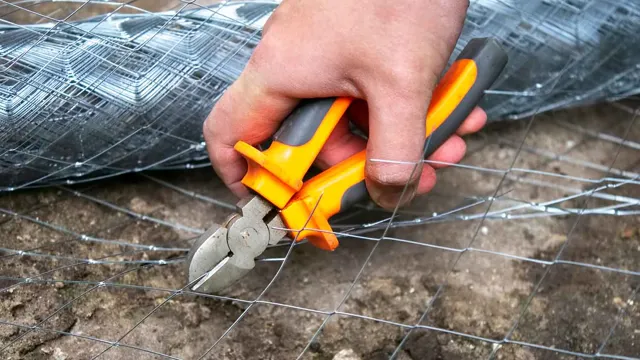
Lubricating oil
When it comes to lubricating oil, there are a few essential tools you’ll need to get the job done right. First and foremost, you’ll need the right type of oil for your particular machine or engine, so be sure to do your research beforehand. Additionally, you’ll need a funnel to pour the oil into the engine without making a mess.
A rag or two will also come in handy for wiping up any excess oil that may spill. A socket wrench or oil filter wrench may be necessary for removing the old oil filter, depending on your make and model. Lastly, an oil pan or container is necessary for catching and disposing of the used oil properly.
By having these tools on hand, you’ll be able to ensure your engine runs smoothly and efficiently, and avoid any potential damage. Remember, it’s always important to follow the manufacturer’s guidelines when it comes to oil changes and maintenance to keep your machine running at its best.
Safety goggles/glasses
When it comes to DIY projects, safety should always be a top priority. One essential tool that every DIYer should have is a pair of safety goggles or glasses. These protective eyewear options are designed to prevent eye injuries while working with power tools or handling hazardous materials.
Safety goggles feature a snug fit that surrounds the entire eye, offering maximum eye protection and preventing debris or chemicals from entering the eyes. Safety glasses, on the other hand, have a more relaxed fit and provide protection from larger debris. Regardless of which option you choose, both safety goggles and glasses are essential tools that can prevent severe eye injuries and ensure that you can enjoy your DIY project safely.
So, the next time you start working on a DIY project, remember to grab your safety goggles or glasses to protect your vision and stay safe while doing what you love.
Step-by-Step Guide
If you’re wondering how to sharpen your wire cutters, don’t worry! It’s actually quite easy. First, make sure your wire cutters are clean and free of any debris. Next, use a sharpening stone to sharpen the blades.
Hold the cutters at a 20-degree angle to the stone and make sure to keep the same angle throughout the process. Start at the base of the blade and move upwards towards the tip, applying even pressure as you go. Repeat the process on the other blade.
Once you’re happy with the sharpness, use a honing stone to remove any burrs from the blades. Test the cutters on a piece of scrap wire to make sure they’re sharp enough for your needs. With a little practice, you’ll be able to sharpen your wire cutters like a pro!
Step 1: Cleaning the Cutters
When it comes to kitchen appliances, blenders are one of the most versatile and convenient tools to have around. But with frequent use, the blades can become dull and inefficient, which is why it’s important to clean them regularly. The first step in cleaning the cutters of your blender is to disassemble the parts and remove any excess food particles or debris.
You can do this by unscrewing the blade assembly from the blender jar and rinsing it under running water. For tougher build-ups, use a soft-bristled brush to gently scrub the blades. Avoid using harsh chemicals or abrasive materials, as this can damage the blades and reduce their longevity.
Once you’ve removed all debris and stains, rinse the blades thoroughly and dry them with a clean cloth. By following these simple steps, you can keep your blender in tip-top shape and ensure that it performs at its best every time you use it.
Step 2: Sharpen the Cutters’ Blade Edges
Once you have removed any debris or rust from your chainsaw cutters, the next step is to sharpen the blade edges. This is crucial for ensuring that your chainsaw works efficiently and effectively. The first thing you need to do is select the correct file size to fit the cutter.
Check the manufacturer’s instructions for the right size. Then, place the file in the cutter’s tooth, ensuring that it matches the angle of the blade’s edge. Sharpen the blade by running the file down the edge in one direction.
Be sure to use the same number of strokes on each tooth to ensure even sharpening. Wearing gloves is essential to keep fingers safe from sharpen blades. Keep a close eye on the filing progress until your see sharp edges begin to form.
Sharpen every other tooth to ensure balance on the chainsaw. Once you have finished sharpening, wipe the cutters with a cloth, or blow them with a compressed air machine to clean off any debris. Now you can reassemble the chainsaw, and it will be ready to use again for your projects.
With regular maintenance and sharpening, your chainsaw can provide years of reliable use, saving you time and money in the long run.
Step 3: Lubricate the Cutters’ Pivot Points and Springs
Lubricate the Cutters’ Pivot Points and Springs To complete the maintenance of your garden shears, you need to lubricate the cutters’ pivot points and springs. This step is important to ensure that your garden shears have smooth action and reduce the stress you feel in your hands while you’re cutting. To lubricate the pivot points and springs, you need to clean the area first.
Use a stiff brush to remove any debris and dirt buildup around it. After cleaning, apply a small amount of oil to the pivot points and springs. You can use any light oil, such as WD-40 or 3-in-1 oil.
Be sure to apply it in small amounts to avoid over-lubricating the area. If you over-lubricate the area, it may cause the cutters to become too slippery, making it difficult to control and may lead to damage or injury. Also, over-lubrication may cause dust and dirt to stick to the blades over time, causing them to dull quickly.
In conclusion, lubricating the pivot points and springs of your garden shears is a crucial step in maintaining your garden tools. It only takes a little effort but can go a long way in ensuring that your garden shears operate at optimum levels for years to come.
Tips and Tricks
Wire cutters are one of the most commonly used tools in any workshop, but over time, they can become dull and less effective. If you’re wondering how to sharpen wire cutters, you’re not alone. Fortunately, it’s a relatively simple process that anyone can do at home.
You’ll need a sharpening stone or file, as well as some lubricating oil. Start by inspecting the blades for any signs of damage or wear. Make sure they’re clean and free of any debris.
Next, you’ll want to lubricate the blades with some oil to prevent them from rusting and to make the sharpening process smoother. Hold the cutter with one hand and the sharpening stone or file with the other. Begin by placing the cutting blade against the stone or file at a 90-degree angle, with the beveled side facing down.
Using moderate pressure, slide the blade back and forth along the stone in a consistent motion. Repeat this process on the other blade, making sure to maintain the same angle and pressure throughout. Once you’ve sharpened both blades, wipe them clean with a cloth and test the cutters to see if they feel sharper.
If not, repeat the process until you’re satisfied with the results. In conclusion, sharpening wire cutters is a simple task that anyone can do with a few basic tools. By following these steps, you’ll be able to keep your cutters in top condition and ensure they last for years to come.
Don’t be afraid to give it a try and see for yourself the wonders of a freshly sharpened pair of wire cutters!
Tip 1: Use the Right Tools
When it comes to any job, using the right tools can make all the difference. This holds true in any industry, and content writing is no different. As a writer, investing in the right tools can improve your productivity and the overall quality of your work.
Software programs such as Grammarly or Hemingway can help identify grammar mistakes and suggest ways to improve your writing. These programs can also provide helpful insights, such as word count and readability scores. Additionally, using a project management tool such as Trello or Asana can help you stay organized and on top of your deadlines.
These tools can help you prioritize your tasks and ensure you don’t miss any important deadlines. By using the right tools, you can streamline your writing process, ultimately leading to a more successful outcome. So, don’t underestimate the power of investing in the right tools for your writing projects.
Tip 2: Consider the Wire Cutter’s Quality
When shopping for wire cutters, it’s important to consider the quality of the tool. Cheaper options may seem tempting at first, but investing in a high-quality wire cutter can save you both time and frustration in the long run. Look for cutters that are made from durable materials like stainless steel, and have comfortable grips to prevent slipping.
Additionally, make sure the blades are sharp and able to cleanly cut through a variety of wire gauges. By choosing a quality wire cutter, you’ll be able to tackle any project with ease and confidence. Don’t skimp on quality when it comes to tools that are essential to your work or hobby.
Tip 3: Use Proper Technique
When it comes to working out, it’s not just about the number of reps or sets you perform, but also the technique used in doing them. To achieve your fitness goals and prevent injuries, it’s crucial to use the proper technique when performing exercises. Using improper form can put unnecessary strain on joints and muscles, increase the risk of injury, and decrease the effectiveness of the workout.
That’s why it’s essential to learn the correct form for each exercise before incorporating it into your routine. Whether you’re lifting weights, doing bodyweight exercises, or performing cardio, proper technique will ensure that you’re targeting the right muscles, working them effectively, and getting maximum results. Don’t rush through your exercises or sacrifice form for speed.
Take the time to learn correct form and make adjustments as needed. Remember, fitness is a journey, and proper technique will help you get there safely and effectively.
Conclusion
In conclusion, sharpening wire cutters is not rocket science, but rather a simple process that requires a bit of patience and finesse. It’s like sharpening your wit – you need to hone it regularly to keep it sharp and ready for any challenge. With the right tools, technique, and mindset, you can turn any dull wire cutter into a precision cutting machine that makes neat and clean cuts every time.
So next time you’re stuck with a pair of blunt cutters, remember the power of sharpening and how it can transform your cutting game. Happy snipping!”
FAQs
What is the best way to sharpen wire cutters?
The best way to sharpen wire cutters is by using a sharpening stone or a honing tool to file the edges of the blades.
Can wire cutters be sharpened at home?
Yes, wire cutters can be sharpened at home. They can be sharpened using a sharpening stone or a honing tool.
Why is it important to sharpen wire cutters?
Sharpening wire cutters ensures that they are cutting effectively and efficiently. This makes the job easier and reduces the risk of injury or damage to materials.
How often should wire cutters be sharpened?
Wire cutters should be sharpened whenever they begin to dull and are not cutting as effectively. Depending on usage, this can be anywhere from once a month to once every few months.
Can wire cutters be sharpened without a sharpening stone?
Yes, wire cutters can be sharpened using other tools such as a diamond file or sandpaper.
What is the proper technique for sharpening wire cutters?
The proper technique for sharpening wire cutters is to hold the blades at a consistent angle and run them along the sharpening surface in a smooth motion.
Are there any safety precautions to take when sharpening wire cutters?
Yes, it is important to wear protective gloves and eye protection when sharpening wire cutters. Additionally, make sure the cutting edges of the blades are kept away from your body.
